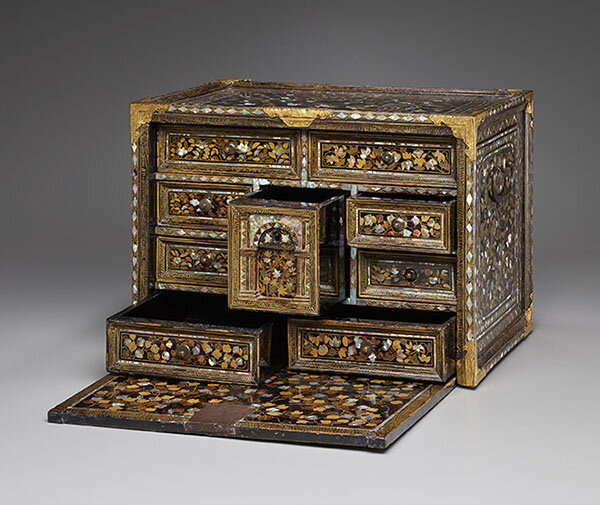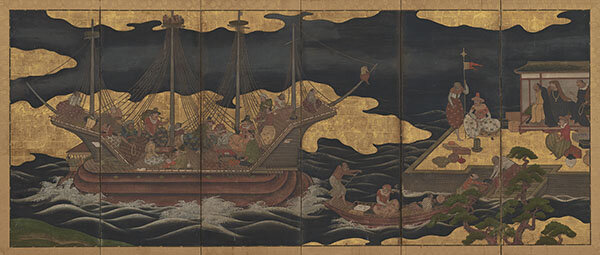February 23–May 21, 2018
Exhibition explores the influence of global trade on the development of a new aesthetic in Japanese art from the mid-16th to the mid-17th century
The Yale University Art Gallery is pleased to announce the opening of Japan’s Global Baroque, 1550–1650, on view in the Jane and Richard Levin Study Gallery from February 23 through May 21, 2018. This focused exhibition explores the influence of global trade on the development of a new visual aesthetic in Japan that featured bold patterns and bright colors, and which paralleled the emergence of the Baroque style in Europe. Drawn from the Gallery’s collection and supplemented by important loans from both public and private collections, the objects on view illustrate the critical role that imported goods played in Japanese culture during this momentous period. In addition to spectacular screens showing the arrival of foreign ships and their crews, the exhibition also features Japanese lacquers produced for domestic use and export, Chinese ceramics made for the Japanese market, and Persian and Indian trade textiles, some of which were refashioned into Japanese clothing.
While politically tumultuous, the 16th and 17th centuries in Japan were also marked by vibrancy and innovation in the visual arts. By the mid-16th century, Japan had suffered through nearly a century of warfare between competing feudal lords (daimyō) but was reunited by three remarkable leaders: Oda Nobunaga (1534–1582), Toyotomi Hideyoshi (1537–1598), and Tokugawa Ieyasu (1543–1616). Their success in reestablishing a central government during the Momoyama (1573–1615) and early Edo (1615–1868) periods was largely due to their possession of superior Western weapons, which were first introduced to Japan in the second half of the 16th century as a result of the burgeoning global trade. Japan’s participation in this trade is traced to 1543, when three Portuguese sailors working on a Chinese junk accidentally landed on the southern coast of Tanegashima island, near Kyushu.
In the second half of the 16th century and the first decades of the 17th, Portuguese ships with multiethnic crews traveled around Africa to ports in China, India, Japan, the Philippines, South America, and West Asia. In addition to exotic animals, spices and other perishables, and raw materials such as ivory, these ships carried books, Indian printed cottons, Chinese silks, Chinese porcelains and lacquers, and other luxuries, all of which were often imitated and repurposed when they reached Japan. Representations of these ships and other European themes appear in Japanese paintings from the same time and are known as “southern barbarian” (nanban) works, as are lacquers and other goods that were made in Japan for these foreigners, or for trade to Europe. Presented together, these objects reveal the flowering of Japan’s own Baroque period.
“Carefully chosen objects in this exhibition exemplify the many ways in which a single work of art can embody multiple stories,” explains Denise Patry Leidy, the Ruth and Bruce Dayton Curator of Asian Art and curator of the exhibition. “Some of these stories reflect the place where the object was made; others reveal the role of trade in the development of local traditions; and still others tell of technology, design, and objects used in daily life.”
On View
February 23–May 21, 2018
Related Programs
Costume Ball
Thursday, March 1, 5:30 pm
“Plaster, Paper, Wood, and Wire”
Gallery Talks
Wednesday, February 28, 12:30 pm
“Foreigners and Exotic Goods in Japan”
Denise Patry Leidy, the Ruth and Bruce Dayton Curator of Asian Art
Wednesday, April 11, 12:30 pm
“Writing Cabinets of the Portuguese Expansion”
Edward S. Cooke, Jr., the Charles F. Montgomery Professor of American Decorative Arts; Director of the Center for the Study of American Art and Material Culture; and Professor of American Studies, Yale University
Lecture
Friday, April 27, 6:00 pm
“The Migration of Forms in the Art of the Jesuit Missions in Asia”
Gauvin Alexander Bailey, Professor and the Alfred and Isabel Bader Chair in Southern Baroque Art, Queen’s University
Keynote lecture for the symposium Japan’s Global Baroque, Friday and Saturday, April 27–28; for more information, visit ceas.yale.edu/japans-global-baroque.
All programs are free and open to the public unless otherwise noted. For more detailed programming information, visit artgallery.yale.edu/calendar.
Exhibition Credits
Exhibition organized by Denise Patry Leidy, the Ruth and Bruce Dayton Curator of Asian Art. Made possible by the Japan Foundation Endowment of the Council on East Asian Studies and the Art Gallery Exhibition and Publication Fund.


